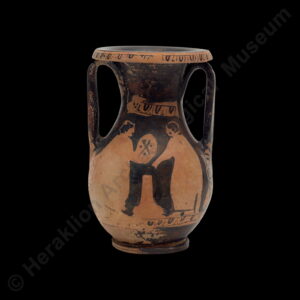
A vase-painting style developed in Attic workshops, becoming very popular in the 5th century BC. The decoration consists of scenes with figures in the natural colour of the clay, with details added in a more liquid black clay slip, creating shading, volume and gradations of colour. The rest of the surface is coated in an alkali or potash clay slip. The strong contrast between the figures and the black ground of the scenes is achieved by controlled firing and alternating the oxidising and reducing phases. Attic red-figure vases, often painted with masterfully rendered mythological scenes, were very popular throughout the Mediterranean and were copied by local workshops.